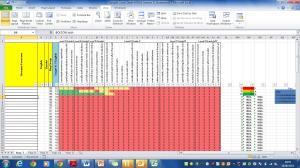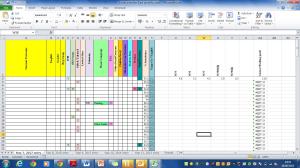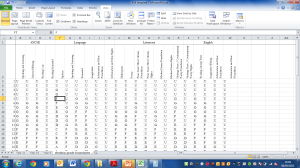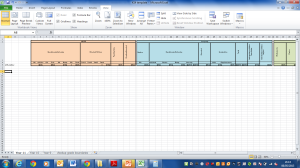Okay.
This is scaring me, now.
I don’t mean scaring in the sense that children enjoy ‘being scared’ by stories and films. I don’t mean scaring in that delicious hide-behind-the-sofa Doctor-Who style.
I mean fully and totally clenchingly scared!
I want to – no, in my head, I have – turned my entire Programme of Study on its head. This puts the decision to swap from OCR to AQA examination boards on a level with, perhaps choosing between Cadbury’s chocolate and Galaxy. Being now permanently appointed, having a clutch of retirees and new appointments, I am rebuilding our curriculum from the foundations upwards.
And I mean from the foundations!
The curriculum I inherited – and, for my transition ‘Acting’ year haven’t really been happy with but equally, for reasons of laziness primarily, haven’t tackled – is I think a pretty traditional one.
We read books and write in response to them.
We analyse language for purposes and write techniques.
We report a single grade to parents.
We have been – and, in fairness to my school so has every other school I have ever worked in – almost wholly Literature focused, content driven and linear in structure.
So what am I changing to? Language focus. Skills driven. Cyclical and elliptical structure.
Head. Turned. Upon.
At the heart of this will be something called Covey tables, available courtesy of the PiXL club and named after Stephen Covey, author of The Seven Habits of Highly Effective People.
Covey tables – at least in my understanding of them – are at their heart a marking tool.
It is possible to list key skills that my students will be assessed on and I have ranked those skills along the top of the spreadsheet. They are drawn from the OCR markscheme for Controlled Assessments. In this case, they focus on AO4(iii) the sentence structures, punctuation, grammar and paragraphing. I planned on experimenting with this first because (as noted in the previous post) the changes to the KS2 curriculum and KS4 curriculum are massively raising the status of these skills. To be reporting to parents, students and SLT that a certain student may be “Level 4b” actually tells them nothing about whether they can create sentences, use paragraphs, vary vocabulary….
As can be seen from the example, teachers need to simply grade from 0-2 for each skill to represent their being no evidence of it, occasional evidence and consistent evidence. Through basic formulae and vlookups, these scores can then be converted into a GCSE grade or KS3 level.
Should I be using KS3 APP Assessment Foci for Years 7-9?
I don’t see why.I am being tested at KS4, students are being examined at KS4. What possible advantage is there in tweaking the descriptors and language of assessment between Key Stages? I am prepared to report in the 4c, 4b, 4a, 5c ladder of the KS3 curriculum (or 4.2, 4.5, 4.8, 5.2 for the sake of the mathematics required by the spreadsheet) but why tinker with the language of assessment?
How do I see these Covey charts being used?
In a word (or three) daily, openly and engagingly.
A two week introductory Scheme of Learning will start by assessing prior skill and 1s entered as a result. It is the first piece of work and therefore by definition, there can be no evidence of consistency. Doing this in the first lessons back in September will mean that the quantity of marking is going to be limited (I am really pushing for regular feedback of shorter focused tasks: having achieved a level 5 in your first half page, do I really need to read another 5 pages of the same quality of writing?!) Once initial testing is done, two weeks of teaching will lead to a second round of tests. PiXL language might describe this as diagnosing, treating and testing? After the second test, the Covey table will be updated: 0s will become 1s; 1s will become 2s. A level can then be reported on. As our reporting cycle requires a report produced in October, this will fit perfectly!
And what do we have as a teacher? A partially completed Covey chart from which we can analyse who in each class can consistently demonstrate certain skills (and, therefore, train others) and who needs practise before their skill can be relied upon. It can be projected onto the board. The next time a student forgets a capital letter or a full stop or loses a chance to deploy a colon in anger, their score can be reduced in front of them! Along with a challenge to correct their writing by the end of the lesson. Students using correct apostrophes for the first time can see their 1 being inputted.
Use for discussion with SLT? Invaluable!
A role in identifying Intervention candidates? Incalculable!
Its place in selecting focussed 30 minute skills’ revision rather than wide ranging generic revision classes? Immense!
Parents’ Evening tool? Potent!
Further Covey tables could be (will be) created for the specific AOs: I think that creating a table of this nature for every level of every skill in every AO on one sheet would be far too cumbersome. And finally, an overview sheet could use formulae and vloookups to simply pull the final grades together for each AO and then average them into an overall grade. Weightings can then be applied as well if necessary.
The onus is on teaching staff to keep each of these Coveys up-to-date: without up-to-date data, this will fall apart as I envisage the Covey chart being used as both a summative tracking database and as a formative interactive teaching tool. And, it will be an onus for at least some of my staff: another chore that would probably fall to the bottom of their to-do lists.
So what can I do to ease other burdens as I impose this one? Well, let’s think:
- marking: the Covey sheet is marking! Mailmerge should allow us to create stickers or labels easily in which a grade is given to the child along with a list of skills which justify that level and other skill required for the next one and this could be generated weekly – although fortnightly fits with the rhythm of our curriculum more naturally;
- planning: if I were to write Schemes of Learning focused exclusively on specific sets of skills – why should a Learning Objective make reference to anything other than these skills which are what they’re being assessed on? – then I both keep control introducing this very new framework and take one other burden from my team.
In fact, all I am asking my Department to do is to deliver (with verve and enthusiasm) my lessons and Schemes of Learning and to differentiate them according to the demands of their own classes.
So, what will this create? An integrated Programme of Study over five years with an integrated and unflinching focus on progress, skills and achievement? A single thread of skills informing Assessment for Learning, Planning, Schemes of Learning and Reporting? A rigorous, accountable and open system of assessment – firming up what may be one of our weaker skill set at Key Stage 3? A consistent marking policy?
Cripes!
And is it a massive burden on me to write Schemes of Learning across all year groups? Well, if it’s the right thing to do, for the sake of the children, that shouldn’t be a bar! And the benefits in terms of reducing marking will apply to me as much as to anyone else. And all I would be doing is sharing and directing others to use the Schemes of Learning which I would be creating for my own teaching any way!
Yes, still scared!
But the more I consider this, the more right it seems!
I have to be trying to teach children to read, write, communicate and (despite its removal from the new KS4 qualification) speak and read. To teach them to answer the set question on a set text is simply not good enough!



